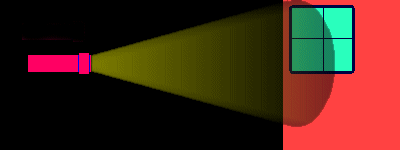Power SystemHow do solar panels supply energy for spacecraft? |
When you're holding something up to a flashlight, you can see it very clearly and brightly. If you shine the flashlight around a room, it's dimmer but has a larger circle. If you go outside and shine the flashlight at the top floor of a tall building, you'll be lucky to see anything at all. If you shine it at the moon, you're not likely to make the moon any brighter!


This is because the flashlight is producing a constant amount of energy, but that energy is being spread as it travels away from the flashlight. If it is spread out over either a small area (when you're holding something close to the bulb) it is bright. If it is spread over a wide area (when you're shining it on a building) it is dim.
The Sun is like the flashlight, shining the same amount of energy in all directions. When a spacecraft is closer to the Sun, it intercepts a lot of light rays (and is lit more brightly). When it is farther out, the light is more diffuse, so the solar panels get less light. DS1's solar panels will be four times less efficient at the end of its mission as they were when it started.
![]()
What are solar panels?
How do solar panels convert the Sun's energy into electricity?
What happens to a ship when it runs out of power?
![]()
Why do solar arrays always have to be oriented towards the Sun?
How efficient are solar panels?
What role does the Sun play in space missions like DS1's?
![]()
How are solar panels made?
How much power does DS1 use? How much power does it produce?
![]()